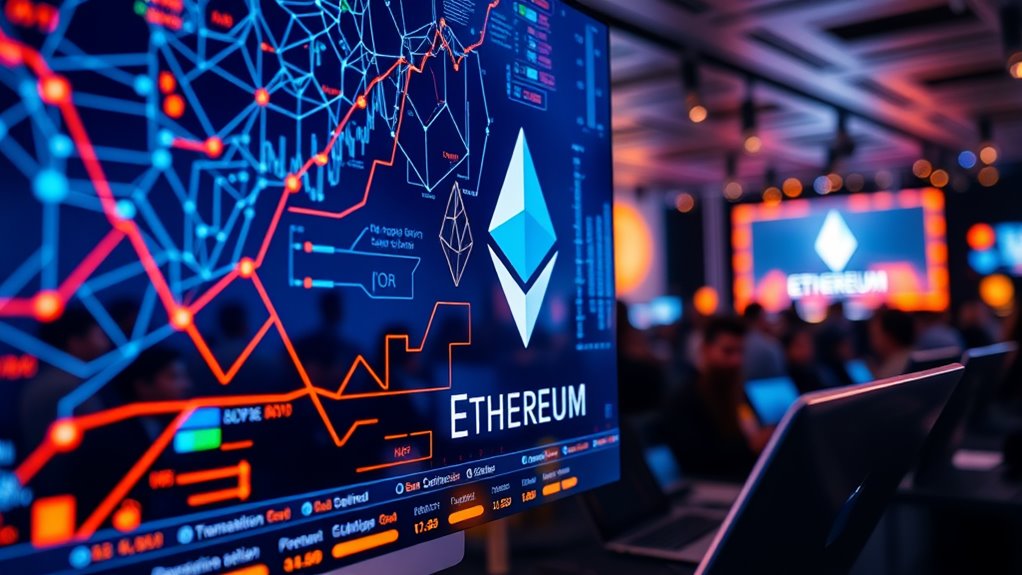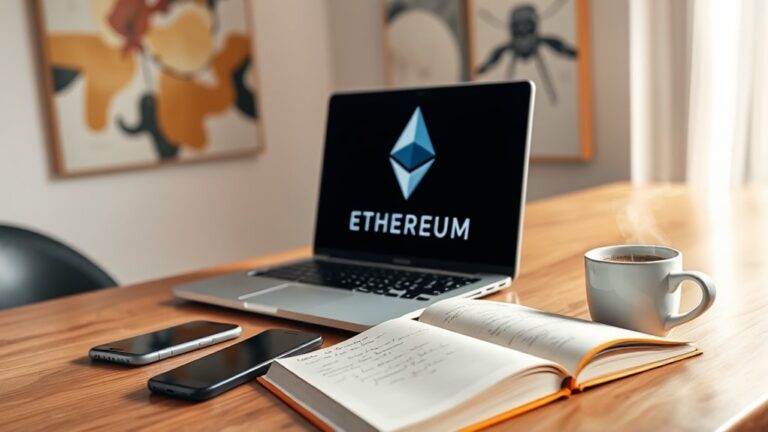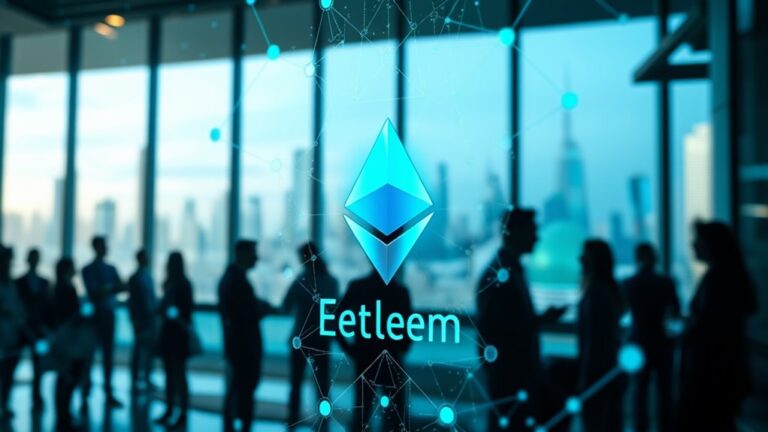
Ethereum Layer 2 Solutions: What Are They & How Do They Work?
Ethereum Layer 2 solutions are scaling technologies that process transactions off the main Ethereum chain while inheriting its security. These systems bundle multiple transactions together before submitting them to the main blockchain, greatly reducing congestion and fees. The main types include rollups (both optimistic and zero-knowledge), state channels, and sidechains. Each solution offers different trade-offs between security, speed, and decentralization. The growing ecosystem of Layer 2 projects continues to transform how users interact with Ethereum applications.
Key Takeaways
- Layer 2 solutions are scaling technologies built on top of Ethereum that process transactions off the main chain.
- They bundle multiple transactions together before settling them on Ethereum’s Layer 1, reducing congestion and fees.
- Rollups (both optimistic and zero-knowledge) validate transactions through different proof mechanisms while inheriting Ethereum’s security.
- State channels enable direct peer-to-peer transactions off-chain, making them ideal for gaming and recurring payments.
- Leading projects include Arbitrum, Optimism, Base, Polygon zkEVM, and zkSync, each offering unique benefits for different use cases.
Understanding the Scalability Challenges of Ethereum

Ethereum, despite its revolutionary impact on blockchain technology, faces numerous scalability challenges as its user base continues to grow. The network currently processes only 15-30 transactions per second, creating significant bottlenecks when demand surges during events like NFT drops or DeFi rushes.
This limited throughput leads to network congestion, causing gas fees to spike dramatically and transaction confirmation times to extend. Developers of decentralized applications must constantly optimize their smart contracts or rely on off-chain solutions to provide acceptable user experiences.
The growing blockchain state further slows verification processes as nodes struggle with hardware capacity limits. These issues exemplify the blockchain trilemma, where Ethereum prioritizes decentralization and security over scalability, creating a fundamental tension that ongoing upgrades like Ethereum 2.0 aim to resolve. Additionally, the implementation of layer 2 solutions is expected to significantly enhance transaction speeds and lower gas fees, making Ethereum more appealing for users.
The Mechanics Behind Layer 2 Technology

Layer 2 solutions fundamentally transform Ethereum’s transaction processing by moving the computational workload off the main blockchain. These solutions operate through a structured approach: transactions are processed off-chain, bundled together for efficiency, and then settled on the Layer 1 blockchain to maintain security and finality.
Layer 2 solutions shift computation off-chain while preserving Ethereum’s security, revolutionizing blockchain scalability through efficient transaction batching and settlement.
The technical mechanisms vary across different Layer 2 implementations. Rollups, for instance, bundle multiple transactions into batches, using either fraud proofs (optimistic rollups) or zero-knowledge proofs (ZK rollups) for validation.
State channels facilitate direct off-chain interactions between parties, only settling on the main chain when necessary.
All Layer 2 solutions inherit Ethereum’s underlying security while dramatically improving scalability, transaction speed, and reducing gas fees—creating a more viable ecosystem for widespread blockchain adoption. Additionally, the transition to Proof of Stake enhances the overall performance of Layer 2 solutions by providing a more energy-efficient and secure environment for transaction processing.
Comparing Different Layer 2 Solutions: Rollups, Channels, and Sidechains

When comparing the landscape of blockchain scaling technologies, three distinct approaches have emerged as frontrunners in the Layer 2 ecosystem: rollups, channels, and sidechains.
Rollups, categorized as Optimistic or Zero-Knowledge (zk), execute transactions off-chain while posting compressed data to Ethereum. Projects like Optimism and Arbitrum use fraud proofs, while zkSync and Starknet employ cryptographic verification for enhanced security. Decentralized finance (DeFi) is significantly impacted by these Layer 2 solutions, as they enhance transaction speed and reduce costs.
State channels enable private, off-chain transactions between specific parties, making them ideal for gaming and recurring payments, though they require participant cooperation.
Sidechains, including Polygon PoS, operate with independent security models and validators. Unlike Layer 2 solutions that inherit Ethereum’s security, sidechains maintain their own consensus mechanisms while enabling cross-chain asset transfers.
Each solution offers distinct advantages depending on specific use cases and security requirements.
Key Benefits of Moving Transactions Off-Chain

Numerous advantages emerge when blockchain operations shift from the main chain to Layer 2 solutions. By processing transactions off-chain, Ethereum’s scalability greatly improves, reducing network congestion while increasing overall throughput. Users benefit from considerably lower transaction fees and faster finality times compared to main chain operations.
Off-chain solutions enhance security and privacy by limiting public data exposure, allowing sensitive information to remain confidential while still leveraging blockchain’s benefits. This approach particularly benefits microtransactions and routine payments that would otherwise be impractical due to high costs.
Complex operations become more manageable through off-chain processing, where computations and data storage occur outside the main blockchain. This enables enterprises to aggregate multiple transactions, optimize resource utilization, and maintain regulatory compliance while still benefiting from Ethereum’s decentralized foundation.
Leading Layer 2 Projects Transforming Ethereum’s Ecosystem

Several innovative projects have emerged as frontrunners in Ethereum’s Layer 2 ecosystem, each offering unique approaches to the network’s scaling challenges.
Arbitrum leads with the largest market capitalization, providing seamless Ethereum integration through optimistic rollups. Base, developed by Coinbase, focuses on regulatory compliance and institutional adoption. Optimism emphasizes community involvement through its Collective, supporting major protocols like Uniswap and Synthetix.
Polygon (formerly Matic) delivers remarkable scalability with its recent zkEVM upgrade, processing up to 7,200 transactions per second.
Meanwhile, zkSync employs zero-knowledge rollups to enhance privacy and security for sensitive applications. Each solution maintains Ethereum’s security while notably improving transaction speeds and reducing costs, making blockchain technology more accessible and practical for everyday use. These advancements are vital for the growth of decentralized finance (DeFi) and other decentralized applications in the evolving Web3 landscape.
Frequently Asked Questions
How Do Taxes Work for Transactions on Layer 2 Solutions?
Transactions on Layer 2 solutions currently fall under general cryptocurrency tax frameworks, with no specific guidance. Users typically report capital gains or losses based on regional tax laws when exchanging or transferring assets.
Can Layer 2 Solutions Operate if Ethereum Experiences an Outage?
Like a ship without a harbor, Layer 2 solutions cannot fully operate during Ethereum outages. They may continue processing transactions but cannot finalize them on the main chain until Ethereum service resumes.
What Happens to My Funds During a Layer 2 Network Upgrade?
During Layer 2 network upgrades, funds remain secure as they’re ultimately settled on Ethereum’s mainnet. Transactions may pause temporarily, but users can typically still withdraw and deposit, though specific functions might be limited.
Are There Privacy Advantages to Using Specific Layer 2 Solutions?
Certain Layer 2 solutions offer notable privacy advantages, including zk-Rollups with zero-knowledge proofs, off-chain transactions in state channels, and Validium’s private data storage, all reducing public blockchain exposure while maintaining transactional security.
How Do Layer 2 Solutions Affect Ethereum’s Long-Term Tokenomics?
Layer 2 solutions may cut Ethereum’s Gordian knot of high fees, increasing user adoption and transaction volume while reducing ETH needed for gas, potentially affecting ETH’s scarcity value and long-term price dynamics.
Conclusion
Ethereum’s Layer 2 solutions represent a critical evolution in blockchain scalability. By processing transactions off the main chain, these technologies reduce congestion while maintaining security. With rollups, channels, and sidechains each offering unique advantages, Ethereum’s ecosystem has expanded beyond what anyone thought possible—handling more transactions in a minute than previous systems could process in a century. As these solutions mature, they’ll continue shaping Ethereum’s journey toward mass adoption.












